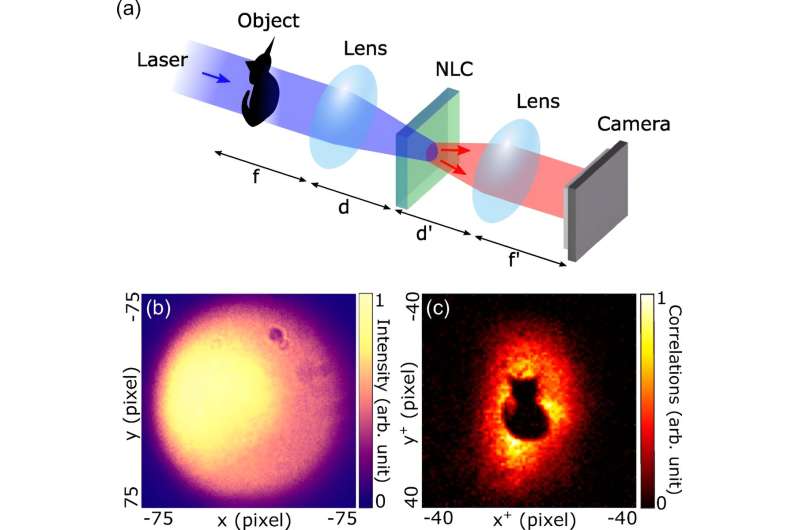This article has been reviewed according to Science X's editorial process and policies. Editors have highlighted the following attributes while ensuring the content's credibility:
fact-checked
peer-reviewed publication
trusted source
proofread
Entangled photon pairs enable hidden image encoding

Researchers at the Paris Institute of Nanoscience at Sorbonne University have developed a new method to encode images into the quantum correlations of photon pairs, making it invisible to conventional imaging techniques. The study is published in the journal Physical Review Letters.
Entangled photons play a crucial role in various quantum photonics applications, including quantum computing and cryptography. These photons can be produced through a process called spontaneous parametric down-conversion (SPDC) within a nonlinear crystal. During SPDC, a single photon from a high-energy (blue) pump laser is split into two lower-energy (infrared) entangled photons.
Some applications require specific types of quantum correlations between these photons, making precise control over them essential. This control can be achieved by tailoring the properties of the pump laser, especially its spatial shape. Exploring this possibility, researchers at the Paris Institute of Nanoscience at Sorbonne University are proposing a method for structuring the spatial correlations of the entangled photons in the shape of a given object.
The experiment consists of placing the object to be encoded in the object plane of a lens located before the crystal and then using a second lens to image it onto the camera (figure 1a).
Without the crystal, this setup is a conventional two-lens imaging system: We expect to observe an intensity (inverted) image of the object on the camera. However, in the presence of the crystal, SPDC occurs, producing pairs of entangled photons in the infrared.
If only these pairs are selected by a spectral filter, the intensity obtained on the camera, after accumulation of many photons, appears uniform and reveals no information about the object (figure 1b). The image of the object reappears only if it is reconstructed from the spatial correlations between the entangled photon pairs (figure 1c), which involves detecting each photon's position relative to its entangled twin.
Reconstructing such an image requires a single-photon sensitive camera along with tailor-made algorithms to identify photon coincidences in each acquisition and extract their spatial correlations.
The image of the object, initially conveyed by the blue laser beam, is thus transferred into the spatial correlations of the photon pairs.
As Chloé Vernière, Ph.D. student and first author of the study, explains, "If we observe the beam in the usual way, counting the photons one by one to form an image, we get the impression that there is no information. But if we focus on the simultaneous arrivals of photons and analyze how they are spatially distributed, a pattern emerges."
Hugo Defienne, Chloé's thesis advisor and last author of the study, adds, "We are really using a rather underexploited degree of freedom of light—namely the spatial correlations between photons—as a canvas on which we print an image. We now want to use this imaging support to develop cryptography systems or imaging in scattering media."
Thanks to its flexibility and experimental simplicity, this approach could enable the development of new imaging protocols and find applications in fields such as quantum communication and cryptography.
By working on the properties of the crystal, it might even be possible to encode several images in a single beam of photon pairs. These images could be revealed by moving the camera to different optical planes, allowing for more information to be encoded.
More information: Chloé Vernière et al, Hiding Images in Quantum Correlations, Physical Review Letters (2024). DOI: 10.1103/PhysRevLett.133.093601. On arXiv: DOI: 10.48550/arxiv.2403.05166
Journal information: Physical Review Letters , arXiv
Provided by Sorbonne University




















